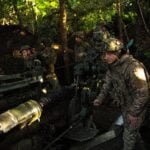As the IAEA supports global efforts to tackle climate change and stop the spread of nuclear weapons, the United Kingdom of Great Britain and Northern Ireland (UK) is an indispensable partner to the Agency.
That was a message from IAEA Director General Rafael Mariano Grossi this week during his three-day visit to the country in which he met with Foreign Secretary James Cleverly and Minister of State for Climate, Graham Stuart; spoke at Chatham House on a number of international challenges facing the IAEA; and toured the Hinkley Point C nuclear power station under construction in Somerset, England.
Meeting with Foreign Secretary Cleverly in London on Monday, Mr Grossi thanked the UK for its support to the IAEA’s mission. The two exchanged views on a number of issues including nuclear verification in the Islamic Republic of Iran and the urgency of avoiding a nuclear accident at Zaporizhzhya Nuclear Power Plant (ZNPP) in Ukraine.
ZNPP is Europe’s largest nuclear power plant, and in September the IAEA established a permanent presence at the plant beset with power outages caused by shelling. The situation places nuclear safety and security at the plant at risk, and Mr Grossi has championed efforts to establish a protection zone at the site. Later this week, Mr Grossi will travel to Moscow to continue consultations with Russian counterparts about bringing such a zone into existence.
Mr Grossi and Mr Cleverly also spoke about nonproliferation commitments in the context of AUKUS, a partnership between Australia, the United Kingdom, and the United States of America. Through AUKUS, Australia seeks to acquire conventionally armed nuclear-powered submarines, which requires special arrangements for nuclear safeguards.
The UK generated just under 15 per cent of its electricity from nuclear power and has plans to develop more nuclear power plants. In a meeting between Mr Grossi and Climate Minister Stuart on Tuesday, the two discussed the IAEA’s Nuclear Harmonization and Standardization Initiative (NHSI). The initiative aims to facilitate the safe and secure deployment of small modular reactors (SMRs), a technology of growing interest for its potential to produce low-carbon energy.
Visiting the UK’s newly established Department for Energy Security and Net Zero, Mr Grossi continued discussions on SMRs and NHSI in a roundtable with representatives of the UK’s regulatory, SMR and advanced module reactor industries. He also met with the Nuclear Skills Strategy Group, the Nuclear Institute’s Young Generation Network and Women in Nuclear UK to exchange on the importance of gender, diversity and inclusion in the nuclear sector.
Chatham House and Hinkley Point C
On Tuesday evening Mr Grossi addressed Chatham House, a think tank and forum on policies and solutions for global challenges. In an event tilted ‘A new nuclear order’, Mr Grossi shared the stage with Patricia Lewis, Chatham House Acting Deputy Director and the lead of its International Security programme, to speak about the IAEA’s experience in Ukraine; the Joint Comprehensive Plan of Action (JCPOA), sometimes referred to as the ‘Iran nuclear deal’; and AUKUS. Watch the conversation on YouTube.
On Wednesday, Mr Grossi visited the site of the Hinkley Point C nuclear power station. The power plant is still under construction with plans to be commissioned in June 2027. When complete, its two pressurised water reactors will provide a total of 3,200 megawatts (MW) of electrical capacity. The UK currently has 5,883 MW of operating nuclear capacity.
“The power station at Hinkley Point C is a statement of the UK’s commitment to nuclear power,” Mr Grossi said. “When completed it will make a significant contribution to the country’s climate ambitions and ensure greater energy security in the UK.”
Hinkley Point C was announced by the government in 2010 and when complete will offset 600 million tonnes of carbon dioxide emissions over its 60-year lifetime, according to EDF Energy. The plant is being built beside the sites of Hinkley Point A and Hinkley Point B, two nuclear power stations that have been permanently shut down and are being decommissioned.
source: iaea












